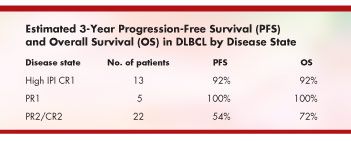Bexxar/BEAM Safe for Transplant Prep in Relapsed DLBCL
In a phase II trial of diffuse large B cell lymphoma (DLBCL) patients with high-risk or relapsed chemosensitive disease, the combination of the radioimmunotherapy (RIT) agent 131I tositumomab (Bexxar) plus BEAM chemotherapy proved safe as an outpatient preparative regimen for autologous peripheral blood stem cell transplant (PSCT)
ASCO-In a phase II trial of diffuse large B cell lymphoma (DLBCL) patients with high-risk or relapsed chemosensitive disease, the combination of the radioimmunotherapy (RIT) agent 131I tositumomab (Bexxar) plus BEAM chemotherapy proved safe as an outpatient preparative regimen for autologous peripheral blood stem cell transplant (PSCT). There was no added toxicity from 131I tositumomab and promising survival results, Julie Vose, MD, of the University of Nebraska Medical Center, reported at the 43rd Annual Meeting of the American Society of Clinical Oncology (abstract 8013).
Tositumomab is a murine IgG2-alpha monoclonal antibody that binds to the CD20 antigen. "This antibody is covalently linked to the radionuclide, in this case 131-indium, which has beta and gamma emissions," Dr. Vose said.
The study included 40 patients with standard high-risk or relapsed chemosensitive CD20-positive DLBCL. "The majority had relapsed disease," Dr. Vose said. Some were in first partial remission and were chemosensitive to salvage therapy, and others were high or high/intermediate IPI (International Prognostic Index) patients in first complete remission after full induction chemotherapy. The majority (88%) had received prior rituximab (Rituxan) and 22% had prior radiotherapy; they had received a median of two prior chemotherapy regimens.

Patients received a therapeutic total body dose of 75 cGy 131I tositumomab, combined with a standard BEAM regimen (BCNU, etoposide, cytarabine, and melphalan), followed by autologous PSCT. At day 100 after transplant, the majority of patients (78%) were in complete remission, 20% had progressed, and one patient refused evaluation. At a median follow-up of 28 months, estimated 3-year progression-free survival was 70% and estimated 3-year overall survival was 81% (see Table for a breakdown by disease state).
As expected, hematologic adverse events were seen in 100% of patients. Late hematologic events (after day 100) occurred in 3% of patients, including one patient with myelodysplastic syndrome at 46 months. Approximately 11% of patients had grade 3-4 atrial fibrillation, 19% bacteremia, and 16% stomatitis. "These are all consistent with historical control patients receiving BEAM alone or rituximab plus BEAM," Dr. Vose said.
Based on these results, she said, a prospective randomized trial (BMT/CTN 0401) is now open comparing rituximab/BEAM vs 131I tositumomab/BEAM as a preparative regimen for chemosensitive persistent or relapsed DLBCL.
Newsletter
Stay up to date on recent advances in the multidisciplinary approach to cancer.
Highlighting Insights From the Marginal Zone Lymphoma Workshop
Clinicians outline the significance of the MZL Workshop, where a gathering of international experts in the field discussed updates in the disease state.
Expanding Horizons in T-Cell Lymphoma Therapy: Focus on Personalized Treatment Strategies
Several lymphoma experts discuss the current T-cell lymphoma landscape, the need for new therapies, and ongoing research in the space.